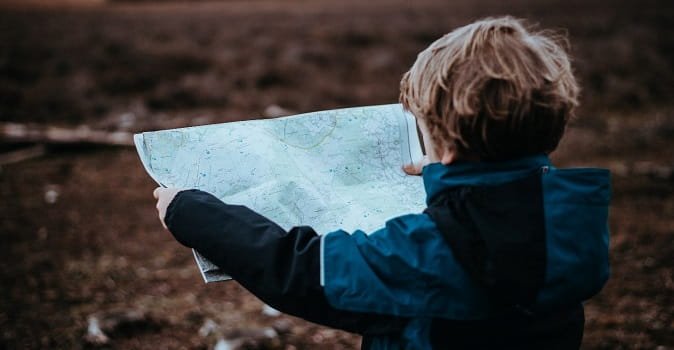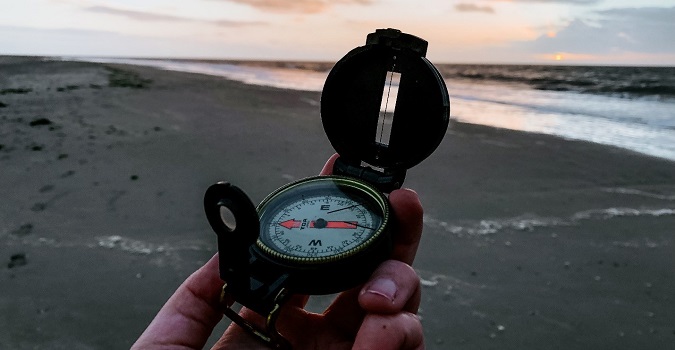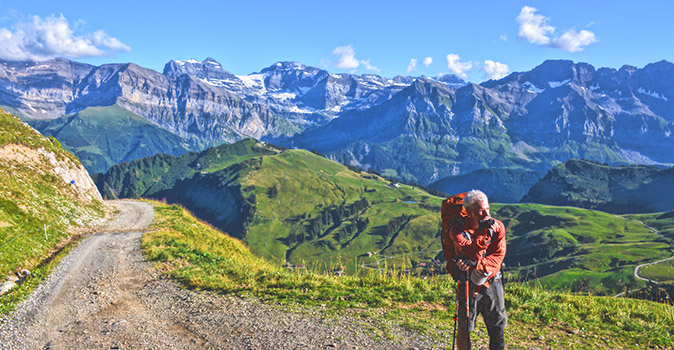Many people have never heard of orienteering, but this woodland exploration sport is highly popular in Europe and is gaining ground across the world. It began as a Swedish military exercise that helped troops build their pathfinding skills, their stamina, and their ability to cooperate with fellow soldiers in unfamiliar situations.
Today, it is accessible to everyone from young children to elderly people. There is now a broad selection of course styles available, including some that incorporate mountain biking, skiing, water navigation, and even night competitions. In this article, you’ll learn how to get started as an orienteer and discover some of the world’s best permanent courses.
Orienteering Definition
Orienteering is essentially a race where the biggest challenge is finding waypoints in woods or urban parks. Competitors, called “runners,” venture into unfamiliar and disorienting terrain. Using only a map and a compass, they must locate a pre-set route through a series of checkpoints before they can cross the finish line.
Basic Skills Needed for Orienteering
Orienteers must be able to use a compass and read an orienteering map without GPS. Some stamina is required as well, but courses are available for most age and ability levels.
Some courses also require orienteers to independently use equipment like skis, mountain bikes, or canoes.
How Does It Work?
Participants must use their supplied map and compass to reach multiple specified areas called “checkpoints” or “controls.” Controls can be located within a few hundred yards of one another or up to a mile apart. In some races, they may be camouflaged or difficult to reach.
Courses can span large areas on terrains of varying difficulty levels. More challenging courses utilize obstacles found in the natural landscape, like bodies of water, woods, and hills. Simpler courses are made up of circuits around more easily navigable areas.

Different rule sets are applied to specific courses, keeping the sport accessible by all ages and experience levels. The difficulty of a course and the average time needed to complete it is always disclosed on maps, on related websites, or by local clubs. Clubs can also inform orienteers of what basic equipment they’ll need for a given course.
What Are the Benefits of Orienteering?
Orienteering is a mental and physical exercise that gets participants out into nature. This sport promotes stamina, independence from technology, and spatial reasoning abilities, as well as cooperation skills.
Types of Orienteering
Orienteering is fun and challenging, but above all, it’s disorienting! Organizers are known to use their imaginations to invent new styles of courses and new rules that keep orienteers on their toes.
You’ll find courses that incorporate trivia questions, courses that require orienteers to run part of the course at night, and courses that use multiple forms of transportation, such as mountain bikes or skis. There are even events where orienteers must use radios to find checkpoints (called Radio-O).
Though most courses present some combination of ways to navigate them and win points, there are a few main types that you’re most likely to come across. Winners are usually determined based on who completes the course fastest, who finds the most checkpoints, and who chooses the best route (or a combination of the three).
The Basic Courses
- Classic: A classic competition, otherwise called cross-country orienteering, is a race where runners must find a number of checkpoints in a specific order before reaching the finish line. The winner is the person or team who completes the course fastest.
- Relay: Relay is, like cross-country orienteering, a race through a set of checkpoints that orienteers must reach in a particular order. The difference is that each member of a relay team runs one leg of the race alone with their own map. Team members must wait until a previous runner finishes a circuit before they can start their own leg of the race. The team with the fastest overall time wins.
- Score: Score orienteering allows participants to reach each checkpoint in any order they wish. Each checkpoint is assigned a point value, determined by its distance from other controls or the difficulty of getting to its location. Some score competitions can last for 24 hours.
- Sprint: Sprint events are shorter races held in urban or park environments where running is easier. Runners must reach checkpoints in a pre-set order, but the point of a sprint event is speed and quick decision-making.
- Motala: Motala orienteering, named for a town in Sweden, is a longer race wherein participants navigate three different courses as part of a single contest. All teams in a motala race start at the same time. The “loops” that each team runs are assigned individually so that no two teams will run them in the same order.
The Best Types for Beginners
- Line: In line orienteering, a route that participants must follow is drawn through multiple checkpoints on each individual’s map. Runners begin a line course one team at a time and must orient themselves to adhere to the specified route as closely as possible. Checkpoints serve as confirmation that they’re on the right track.
- Route: Route orienteering is a lot like a line competition. However, instead of having the route drawn on a runner’s map, the line is drawn on the ground. Participants must mark checkpoint locations on their maps. The winner is the team that manages to spot the most checkpoints.
- String: In string orienteering, competitors follow a string stretched around a course, recording certain items or landmarks along the way. This type of competition is usually reserved for children and beginners. It is more about being observant and working with a team than direction finding.
Tips for Orienteers
Come Prepared
The strictest rule of orienteering is that there’s no GPS use allowed during a race. Before you run your first course, spend some time learning to use the tools you’ll need on the trail: an orienteering map and compass.
An orienteering map looks much like your average topographical map, but with more specific markings to demonstrate the nature of the terrain. The International Orienteering Federation has created a standardized set of map symbols that are used to mark checkpoints and signify specific areas.

Familiarize yourself with orienteering map symbols and make sure you learn how to use a compass so you can orient yourself on a map without GPS.
Limit Your Risk When Orienteering Abroad
Orienteering is a highly active sport. It can encompass numerous physical activities, like hiking, mountain biking, and skiing, and can take you into some very challenging environments. If you’re thinking of trying a course or event outside of your home country, consider whether you need travel health insurance to provide coverage for unexpected injuries, illnesses, and travel mishaps during your time abroad.
Many regular health insurance plans do not cover policyholders while they’re in foreign countries. Others provide international coverage only under limited circumstances. If you already have a traditional health plan, review your coverage or talk to your provider to find out whether you need to purchase an adventure travel health insurance policy like Atlas Travel insurance for your time abroad.
PRO TIP: Read the Description of Coverage for any travel health insurance policy you’re considering carefully. Pay attention to the benefit limits, conditions, and exclusions. For example, a plan may cover mountainside orienteering but exclude activities at elevations above a certain height. It may cover many of the activities involved in some orienteering courses, such as mountain biking, but exclude high-risk activities like motorized dirt biking. The policy may also require you to wear safety gear for a specific activity, such as a helmet and goggles for snow skiing.
View the Description of Coverage for Atlas Travel insurance here.
Find an Orienteering Club
The best place to get started as an orienteer is with a local club. Hundreds of clubs exist across multiple countries and continents. They provide members with information about permanent courses, events, and other resources.
Most also organize their own events and outings. If you’re looking for a team to join, find a club near you and sign up for its mailing list.
FYI: Orienteering Is Great Practice for Hikers and Backpackers
Orienteering is an ideal way for prospective hikers to hone their map-reading skills and build endurance for an upcoming adventure. It’s also a perfect opportunity to try out the weight and balance of a fully loaded backpack. For more backpacking tips and a checklist of what to bring on a long hike, explore our article “The Best Backpacking Tips & Destinations for 2020.”
Orienteering Places: The Best Permanent Courses
Lots of countries host major orienteering competitions for all levels, both locally and nationally. There’s even an Orienteering World Cup that’s staged across multiple countries each year. However, competitions aren’t your only option for participating in orienteering.
Most competition courses are set up as temporary venues that are dismantled when an event is over. But if you look for permanent trails, either locally or in your travel destination of choice, you’re likely to find plenty of opportunities to try this sport whenever you like.
The following are some of the best-maintained, permanent orienteering locations in the world. You’ll find multiple courses to suit every ability level at these public parks. Visit them on your own schedule and run them on your own terms.
Bastrop State Park in Texas, USA:
One of the best permanent locations in the USA is Bastrop State Park’s course just outside of Austin, Texas. You can find an orienteering map at the park’s entrance. Contact the Houston Orienteering Club to get an event schedule and attend one of their practice meets to make some new friends.
When you’re done with the course, it’s just a 30-mile highway ride into Austin, the Texas state capitol and one of the most vibrant cities in the country.
PRO TIP: Visit OrienteeringUSA.org to find other permanent courses in the USA.
The Canmore Nordic Centre in Alberta, Canada:
Canmore’s Nordic Centre Park is home to craggy mountains and pine forests. It stands as a major draw for snow skiing and mountain biking orienteers. The park’s day lodge was built for the 1988 Winter Olympics and remains a major travel destination to this day.

Here you’ll find four courses that range from short to long, offering options for all ages. Visit Trail Sports to find orienteering maps and information. This site serves as the locus between all of this area’s courses.
Spa Thermal Park in Taupo, New Zealand:
Rolling hills, green forests, and irresistible blue lakes fill Taupo, New Zealand’s Spa Thermal Park. Here you’ll find four permanent courses with lengths of 1.5km to 5.6km, and with difficulty ratings for almost any group.
Stop by the Taupo Events Centre to pick up maps and punch cards to mark off your checkpoints. The cost to run Taupo’s trails is $5 for adults and $3 for kids. Contact the Taupo Orienteering Club for more information or visit Orienteering.org.NZ to find other permanent New Zealand courses.
The Parques in Porto, Portugal:
Gorgeously maintained parks dot Portugal’s shoreline just off the North Atlantic Ocean. Orienteers can choose from multiple parks in the area, but three parks have orienteering maps available from Desportivo 4 Caminhos Group. Visitors will find short, medium, and long courses in Porto’s parques and also in the Porto City Race, which opens annually.




